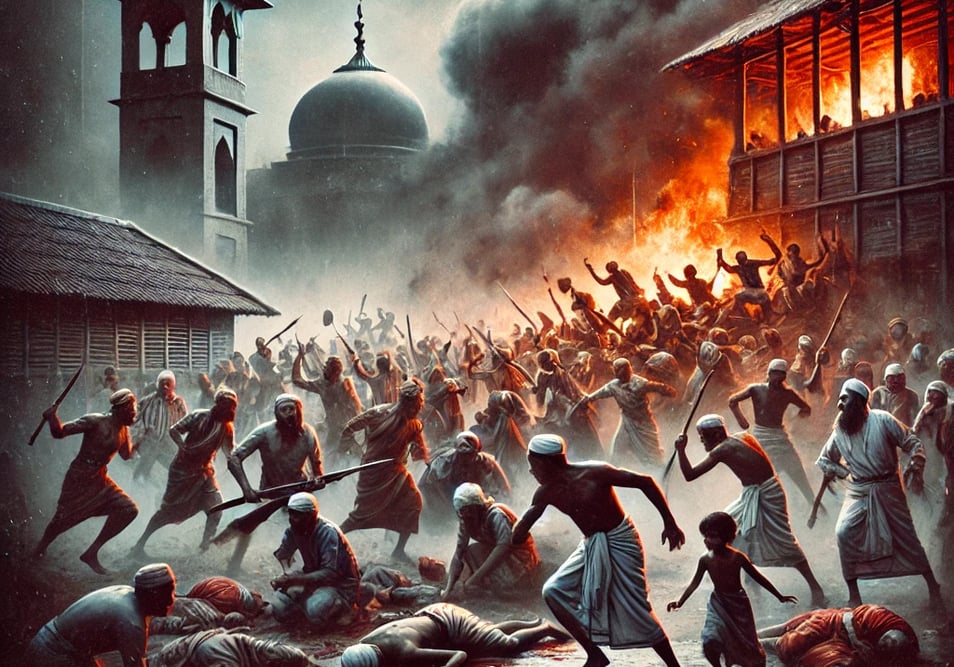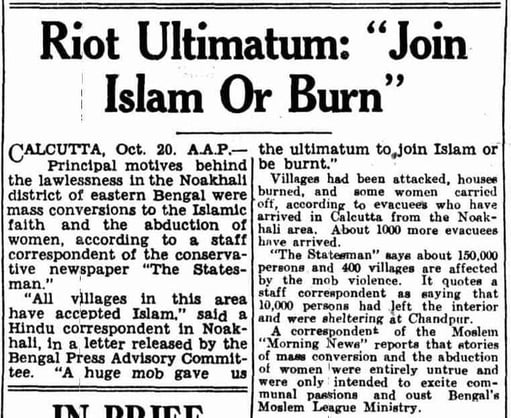Noakhali Hindu Massacre
The Riots of 1946
HISTORY
Madan Mohan
10/11/20244 min read


The silent waters of the Feni River were a standing witness to one of the most gruesome chapters in the history of India—the Noakhali Riots of 1946. The Noakhali riots, a devastating chapter in Bengal’s history, occurred in October and November of 1946, just before India gained independence. These riots largely targeted against Hindus, were characterized by horrific acts of violence, including murder, rape and looting. The violence erupted in the districts of Noakhali and Tipperah impacting over 2,000 square miles of land and affecting areas like Ramganj, Begumganj, Lakshmipur, and Raipur. The atrocities lasted for over a week, leaving tens of thousands of Hindus trapped under the strict control of the Muslim majority, where the administration seemed powerless to intervene.
PRELUDE
The riots began on the sacred day of Kojagari Lakshmi Puja, a time of religious observance for Hindus. Tragically, instead of celebrations, the Hindu community found itself at the mercy of organized Islamic mobs at their door steps. The violence was so intense that many were forced to flee, with survivors eventually migrating to West Bengal, Assam, and Tripura.
THE CAUSES BEHIND THE VIOLENCE
The catalyst for this riots was the Great Calcutta Riots, which had recently occurred, fuelling communal tensions across Bengal. False rumours circulated that the Hindu zamindar of Ramganj, Rajendralal Roy Choudhury, announced a sacrifice of a Muslim boy during a religious ritual, igniting further outrage. The immediate occasion for the outbreak of the disturbances was the looting of a market in Ramganj following a mass meeting and a provocative speech by Gholam Sarwar Husseini for the attacks on Surendra Nath Bose and Rajendralal Roy Choudhury. The fragile relationship between Hindus and Muslims, already under strain, could not withstand the provocations, leading to an eruption of violence on October 11, 1946.
UNFOLDING OF THE VIOLENCE
The Noakhali Bar Association and the Noakhali District Hindu Mahasabha president, Rajendralal Roy Choudhury, was attacked at home on October 11 by Gholam Sarwar's private army, the Miyar Fauz. After valiantly defending his family and home, he was ultimately killed. Rajendralal Roy Choudhury's head was presented to Gholam Sarwar Husseini on a platter as a symbol of victory. Such brutal acts sent waves of fear through the Hindu community, making it clear that the violence was not just random chaos but part of a systematic campaign against the community.
The violence in Noakhali took on horrifying forms. Villagers reported being attacked with deadly weapons, Hindu houses were looted and set to fire, and women were assaulted and raped. The religious hatred was seen on the streets, with Hindu men being forced to convert to Islam or perform Muslim prayers. Hindu temples were vandalized, idols were broken, and the symbols of the Hindu faith were torn apart. As per Gandhian Ashoka Gupta's report, at least 2000 Hindus had been forced to change their religion to Islam. But the then Governor of Bengal, Edward Skinner Simpson stated that there were more than 22,000 forcible conversions during Noakhali riots.
RELIEF AND RECOVERY
Despite the terror, relief efforts began to take shape. Organizations like the Bharat Sevashram Sangha, the Indian National Congress, and the Hindu Mahasabha set up camps to provide aid to the survivors. Relief missions were carried out to rescue abducted women and provide basic necessities to the refugees. The Bengal Provincial Hindu Mahasabha, inaugurated a well-equipped 25-bed hospital in Lakshmipur in memory of Rajendralal Roy Choudhury. On December 9, 1946, Leela Roy spearheaded an important rescue mission, traveling 90 miles from Chaumohani to Ramganj. Along with her team, she successfully saved 1,307 girls who had been abducted by muslim mob during the riots. Leela Roy’s organization, the National Services Institute, also set up 17 relief camps in the impacted area. Mahatma Gandhi personally took part in efforts to help abducted women. He arranged for four rescued Hindu girls to be sent to Sujata Devi, the daughter-in-law of Deshbhandu Chittaranjan Das, for rehabilitation.
Mahatma Gandhi’s visit to Noakhali in November 1946 remains one of the most important moments in the aftermath of the riots. His mission was clear—to promote peace and communal harmony. Gandhi walked barefoot from village to village, holding prayer meetings and attempting to bridge the gap between Hindus and Muslims. But his efforts were met with mixed reactions. Many Muslims opposed his presence, and said his presence has harmed the Muslim community enormously and even started boycotting his prayer meetings.
AFTERMATH AND LEGACY
The aftermath of the Noakhali riots left a legacy of pain and agony. Thousands were forced to convert; their religious identity was stripped away. The Hindu population in the region, once vibrant and prosperous, was decimated by the Islamic mob. The Noakhali riots were not just a dark episode of violence; they were a chilling reminder of the fragility of communal harmony on the face of partition and the religious hatred by one community. Despite the efforts, the partition of India in 1947 further deepened the divisions, leading to mass migrations and unprecedented sufferings on both the sides
Today, the events in Noakhali is a standing example for the horrors conducted by one community and the cost of secularism which never pays off when followed only one side. The Noakhali Riots marked an important chapter in the ongoing struggle of Hindus. Even today, the Hindu minority in Bangladesh faces persecution, forced conversions, and targeted violence. What happened in 1946 remains a symbol of unchecked extremism by the Muslim community that still haunts the region. Despite these injustices, the plight of Bangladeshi Hindus in going unnoticed by the United Nations and the global community. Their stories remain untold, much like the bloodshed that once soaked the banks of the Feni River. In the end, the Feni River still flows, a silent witness to the forgotten voices of those who were perished by the religious killings of Muslim community and those who survived against these literal human hunters.


References:
Noakhali:1946 (in Bengali) by Suhasini Das published from The Dhaka Sahitya Prakash in 2004
Behind The Partition Of The Country (in Bengali) by Kali Prasanna Mukherjee published from the Kolkata Vivekananda Sahitya Kendra in 2003
1946: The Great Calcutta Killings and Noakhali Genocide by Sinha, Dinesh Chandra; Dasgupta, Ashok published from the Himangshu Maity in 2011
Mahatma Gandhi: The Last Phase. Vol. I by Pyarelal Nayyar published from The Ahmedabad Navajivan Publishing House in 1966.
Excerpts from "Noakhali's Darkest Hour" by Andrew Whitehead published in The Indian Express on 20 May 1997.
